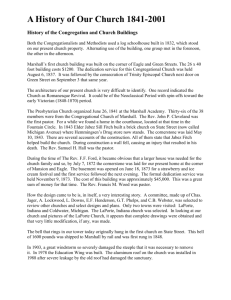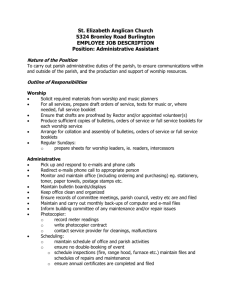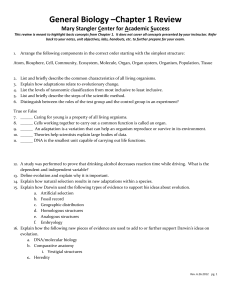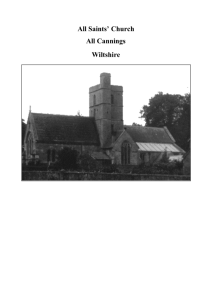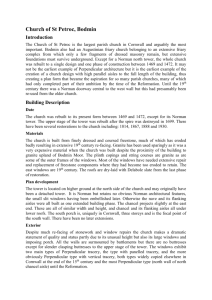C1120 Nave dates from this period. Chancel slightly later and was
advertisement
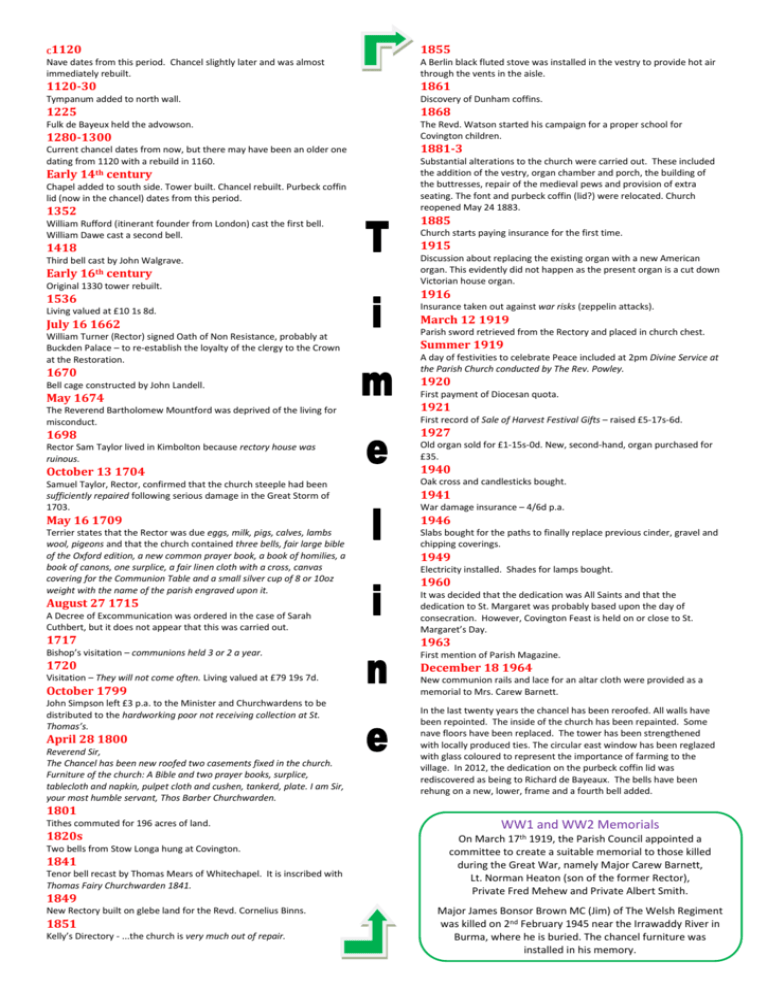
C1120 1855 Nave dates from this period. Chancel slightly later and was almost immediately rebuilt. A Berlin black fluted stove was installed in the vestry to provide hot air through the vents in the aisle. 1120-30 1861 Tympanum added to north wall. Discovery of Dunham coffins. 1225 1868 Fulk de Bayeux held the advowson. The Revd. Watson started his campaign for a proper school for Covington children. 1280-1300 Current chancel dates from now, but there may have been an older one dating from 1120 with a rebuild in 1160. Early 14th century Chapel added to south side. Tower built. Chancel rebuilt. Purbeck coffin lid (now in the chancel) dates from this period. 1352 William Rufford (itinerant founder from London) cast the first bell. William Dawe cast a second bell. 1418 Third bell cast by John Walgrave. Early 16th century Original 1330 tower rebuilt. 1536 Living valued at £10 1s 8d. 1881-3 Substantial alterations to the church were carried out. These included the addition of the vestry, organ chamber and porch, the building of the buttresses, repair of the medieval pews and provision of extra seating. The font and purbeck coffin (lid?) were relocated. Church reopened May 24 1883. 1885 Church starts paying insurance for the first time. 1915 Discussion about replacing the existing organ with a new American organ. This evidently did not happen as the present organ is a cut down Victorian house organ. 1916 Insurance taken out against war risks (zeppelin attacks). July 16 1662 March 12 1919 William Turner (Rector) signed Oath of Non Resistance, probably at Buckden Palace – to re-establish the loyalty of the clergy to the Crown at the Restoration. Summer 1919 1670 Bell cage constructed by John Landell. Parish sword retrieved from the Rectory and placed in church chest. A day of festivities to celebrate Peace included at 2pm Divine Service at the Parish Church conducted by The Rev. Powley. 1920 May 1674 First payment of Diocesan quota. The Reverend Bartholomew Mountford was deprived of the living for misconduct. First record of Sale of Harvest Festival Gifts – raised £5-17s-6d. 1698 Rector Sam Taylor lived in Kimbolton because rectory house was ruinous. 1921 1927 Old organ sold for £1-15s-0d. New, second-hand, organ purchased for £35. October 13 1704 1940 Samuel Taylor, Rector, confirmed that the church steeple had been sufficiently repaired following serious damage in the Great Storm of 1703. Oak cross and candlesticks bought. 1941 May 16 1709 1946 Terrier states that the Rector was due eggs, milk, pigs, calves, lambs wool, pigeons and that the church contained three bells, fair large bible of the Oxford edition, a new common prayer book, a book of homilies, a book of canons, one surplice, a fair linen cloth with a cross, canvas covering for the Communion Table and a small silver cup of 8 or 10oz weight with the name of the parish engraved upon it. Slabs bought for the paths to finally replace previous cinder, gravel and chipping coverings. August 27 1715 A Decree of Excommunication was ordered in the case of Sarah Cuthbert, but it does not appear that this was carried out. 1717 Bishop’s visitation – communions held 3 or 2 a year. 1720 Visitation – They will not come often. Living valued at £79 19s 7d. October 1799 John Simpson left £3 p.a. to the Minister and Churchwardens to be distributed to the hardworking poor not receiving collection at St. Thomas’s. April 28 1800 Reverend Sir, The Chancel has been new roofed two casements fixed in the church. Furniture of the church: A Bible and two prayer books, surplice, tablecloth and napkin, pulpet cloth and cushen, tankerd, plate. I am Sir, your most humble servant, Thos Barber Churchwarden. War damage insurance – 4/6d p.a. 1949 Electricity installed. Shades for lamps bought. 1960 It was decided that the dedication was All Saints and that the dedication to St. Margaret was probably based upon the day of consecration. However, Covington Feast is held on or close to St. Margaret’s Day. 1963 First mention of Parish Magazine. December 18 1964 New communion rails and lace for an altar cloth were provided as a memorial to Mrs. Carew Barnett. In the last twenty years the chancel has been reroofed. All walls have been repointed. The inside of the church has been repainted. Some nave floors have been replaced. The tower has been strengthened with locally produced ties. The circular east window has been reglazed with glass coloured to represent the importance of farming to the village. In 2012, the dedication on the purbeck coffin lid was rediscovered as being to Richard de Bayeaux. The bells have been rehung on a new, lower, frame and a fourth bell added. 1801 Tithes commuted for 196 acres of land. 1820s Two bells from Stow Longa hung at Covington. 1841 Tenor bell recast by Thomas Mears of Whitechapel. It is inscribed with Thomas Fairy Churchwarden 1841. 1849 New Rectory built on glebe land for the Revd. Cornelius Binns. 1851 Kelly’s Directory - ...the church is very much out of repair. WW1 and WW2 Memorials On March 17th 1919, the Parish Council appointed a committee to create a suitable memorial to those killed during the Great War, namely Major Carew Barnett, Lt. Norman Heaton (son of the former Rector), Private Fred Mehew and Private Albert Smith. Major James Bonsor Brown MC (Jim) of The Welsh Regiment was killed on 2nd February 1945 near the Irrawaddy River in Burma, where he is buried. The chancel furniture was installed in his memory.



